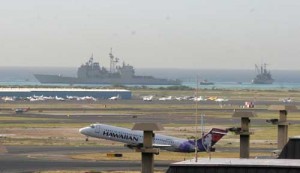What does an F-22 cost?
http://original.antiwar.com/wheeler/2009/03/27/what-does-an-f-22-cost/
What Does an F-22 Cost?
Posted By Winslow T. Wheeler On March 27, 2009 @ 8:00 pm In Uncategorized | Comments Disabled
On Wednesday, March 25, an F-22 crashed near Edwards Air Force Base, CA. Very sadly, the pilot was killed. The news articles surrounding this event contained some strange assertions about the cost of the F-22. The tragic event was apparently used to disseminate some booster-baloney.
Possibly based on the price asserted in the Air Force’s “fact” sheet on the F-22 that was linked to a Pentagon “news” story on the crash, the cost per aircraft was typically described in many media articles as about $140 million.
What utter hogwash.
The latest “Selected Acquisition Report” from the Defense Department is the most definitive data available on the costs for the F-22. The SAR shows a “Current Estimate” for the F-22 program in “Then-Year” dollars of $64.540 billion, which includes both R&D and procurement. That $64.5 billion has bought a grand total of 184 aircraft.
Do the arithmetic: $64.540/184 = $350.1. Total program unit price for one F-22, what approximates the “sticker price,” is $350 million per copy.
So, where does the bogus $143 million per copy come from? Most will recognize that as the “flyaway” cost: the amount we pay today, just for the current production costs of an F-22. (Note, however, the “flyaway” cost does not include the gas, pilot, et cetera needed to fly the aircraft away.)
Advocates of buying more F-22s assert they can be had for this “bargain basement” $143 price in their lobbying – now rather intense – to buy more F-22s above and beyond the 184 currently contracted for. That is, they argue, the “cost to go” for buying new models, which do not require a calculation to amortize the early R&D and other initially high production costs across the fleet. It’s what we’re paying now for F-22s in annual appropriations bills. Right?
Hopefully, it will neither surprise nor offend you to say that assertion is pure bovine scatology.
Congressional appropriations bills and their accompanying reports are not user-friendly documents, but having wadded through them for the past 30 years, I know their hiding holes. The F-22 program has many. Let’s check through the 2009 congressional appropriations for the F-22. Most – but not all – of the required information is contained in HR 2638.
In the “Joint Explanatory Statement” accompanying the bill, the House and Senate appropriators specified that $2.907 billion was to be appropriated for 20 F-22s in 2009. The math comes to just about what the Air Force said, $145 million per copy. So, what’s the problem?
There’s more; plenty more. Flipping down to the section on “modification of aircraft” we find another $327 million for the F-22 program.
Switching over to the Research and Development section, we find another $607 million for the F-22 under the title “Operational System Development.”
Some will further know it is typical for DOD to provide “advance procurement” money in previous appropriations bills to support the subsequent year’s purchase of major equipment. In the case of the 2009 buy of 20 F-22’s, the previous 2008 appropriations bill provided “advance procurement” for “long lead” items needed to be purchased in advance to enable the 2009 buy. The amount provided was $427 million.
Here’s the arithmetic: $2.907 + $.327 + $.607 + $.427 = $4.268 billion for 20 aircraft. That’s $213 million each.
Please do not think these data represent an exceptional year. If you check any of the last few annual buys of F-22s, you will find the same pattern: in addition to the annual “procurement” amount, there is additional “modification,” “operational system development,” and advance procurement.
F-22s are costing these days a little over $200 million each. Period.
Well, actually, there’s more. Last November, Acquisition Czar John Young told the press that the first 100 F-22’s built need an additional $8 billion in R&D and procurement costs to bring them all up to their originally mandated requirements. Ergo, the total program unit cost is not $350 million each, it’s $394 million, assuming Young is correct. The annual purchase, “cost to go” (“flyaway”), price will also go up, but just how much is not calculable right now.
For those sticklers who also want to know how much it will cost to maintain and operate the F-22, you can forget all those promises that it would be cheaper than the aging F-15 it is supposed to replace. Data released by the Pentagon shows that for 2008 each aging F-15 C in the inventory cost, on average, $607,072.92 to maintain and operate. Pricey, but to be expected for such an old airplane.
The F-22’s care and feeding is a little more. In 2008, each cost $3,190,454.72 to maintain and operate: that’s more than five time the cost to run a decrepit F-15.
OK, so the F-22 is really pricey and the Air Force and its boosters are full of baloney on the cost, but it’s a great airplane, a real war winner, right?
Oh, please. Consider the source. More on that later.










